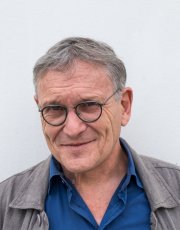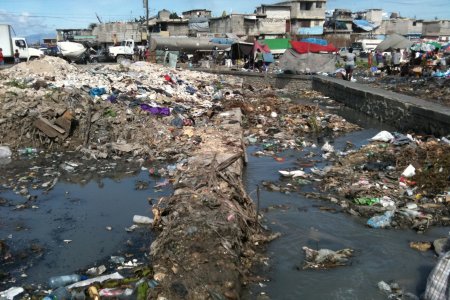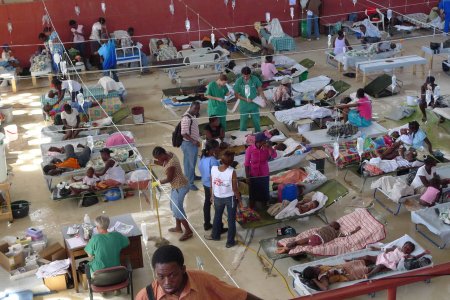
About "Choléra, Haïti, 2010-2018, Histoire d’un désastre" by Renaud Piarroux
Rony Brauman
The cholera outbreak in Haiti in October 2010 was among the deadliest in modern history, with 800,000 people infected and 10,000 fatalities. And these are just the official figures. The actual death toll was far higher, as evidenced by numerous retrospective mortality surveys, and can only be expressed as an order of magnitude: to wit, several tens of thousands.
MSF was on the front line during the acute phase of the outbreak, treating thousands of people in emergency centres set up using a tried and tested method (cholera treatment centres) that was reproduced on a large scale in Haiti in 2010-2011. Like January’s earthquake, this was a true emergency, with mortality rates exploding during the first six weeks and the teams working within a very tight timeframe. The figures speak for themselves: some 10,000 people fell ill in two days in the Artibonite river region, which - to use Professor Renaud Piarroux's expression - was transformed into a "bacteriological bomb".This epidemiology doctor specialised in cholera was called in at the start of the epidemic by the French Embassy in Haiti to provide support to the Haitian Ministry of Health. He is also the person who revealed the human origin of the disaster: a camp of UN peacekeepers from Nepal, situated further upriver in the commune of Mirebalais. This year, he published Choléra, Haïti 2010-2018, histoire d’un désastre (CNRS Editions) in which he relates the long battle to bring the outbreak under control and describes the operation led with the Haitian teams between 2011 and 2018 to rid the country of the disease once and for all. In his book, Professor Piarroux highlights the importance of maintaining early intervention teams in the residual foci in rural and mountainous areas once the initial epidemic shock was over and the main international operators had withdrawn.
Anyone interested in epidemics - the scientific controversies they provoke, the social shocks they generate, their political dimensions - will find much to read in this book. It combines the observations of an academic specialist and recommendations for preventive and curative interventions likely to be of considerable interest to practitioners. These observations and recommendations are very closely linked, and are particularly meaningful given the scientific controversy on cholera in which Renaud Piarroux is engaged. Here are the key aspects of this controversy.
According to the prevailing environmentalist theory, the silent presence of the vibrio cholerae, especially in plankton and algae, is at the origin of epidemic explosions that are unavoidable as they occur naturally. The bacterium lies dormant in the environment until it is woken by a confluence of events (perfect storm). Thus, the upset in marine physico-chemical and biological balances caused by the earthquake in January 2010 was deemed a determining factor in the outbreak that occurred in October of the same year. And this was the interpretation of events promulgated by the UN authorities and supported by the CDCCenters for Disease Control and Prevention: a US federal epidemiological investigation body with a worldwide reputation. It has played a key role in most of the major epidemics since the Second World War , notably polio, smallpox and flu., notwithstanding one huge fact: the distance between the explosive onset of the outbreak and the epicentre of the earthquake - which was inland. It was also maintained by the PNAS journal of the US National Academy of Sciences in its June 2012 issue.
But Renaud Piarroux disputes this theory. It is his belief that the vibrio was introduced by human carriers, i.e. sick but undiagnosed people and healthy carriers imported the germ and contaminated the water supply points, creating the initial foci which then propagated in the same way. The intensity of the epidemic spread was due to the quantity of vibrios released. Although the vibrio is indeed present in the ecosystems described in the environmental theory, this was a non-pathogenic strain, writes Renaud Piarroux. To support his theory, the author retraces the route taken by the vibrio found in patients from Nepal (where an epidemic was underway at the same time) to the peacekeepers’ camp where many of the soldiers were sick and then on to the towns and villages along the river that constituted the populations’ water supply. It was because the camp’s septic tanks were emptied into the river that the above-mentioned bacteriological bomb was created. In other words, we are no longer talking about a regrettable natural disaster, but a scandalous industrial accident.
This paradigm shift has heavy consequences: the cholera outbreak was not due to the vagaries of nature, but to human error. However, the purpose of this book is not to identify the guilty parties, although compensation for the damage caused is still an issue. It is to draw attention to the possibility of developing a realistic means of prevention – something which was attempted with varying degrees of success and considerable difficulty (and recounted in detail) by Renaud Piarroux and the teams put in place by the Ministry. In any case, no new cases have been reported over the last 12 months, which bodes well for the elimination of the endemic risk.
But there still remains the doctoring, dissimulation and truncated debates which marked this period - and this part of the tale is flabbergasting. For example, there were the CDC epidemiologists who saw no need to pronounce on the origins of this outbreak, despite this being one of their raisons d’être and having the possibility to use the bacterial strain for genetic identification. Then there was the destruction of evidence of what was released into river, as well as the disappearance of the Nepalese soldiers’ medical records, the invention of non-existent peaks in rainfall, the suggestion of an El Nino connection (as in the cholera epidemic in Peru in the 1990s) and much twisting of the facts to make them fit the theory of an environmental origin.
But why go to so much trouble? What was so important that it had to be kept hidden? Firstly, there was the UN’s responsibility in this disaster - a big issue as the presence of the peacekeepers was politically sensitive. Indeed, the story of the sudden post-seismic awakening of a dormant bacterium was manna from heaven for the UN’s protectors, and was exploited to the full. This instrumentalization of the environmental theory was possible, and effective up to a point, thanks to the scientific influence of a researcher in microbiology, Professor Rita Colwell. This academic, who had been working on cholera since the 1960s and was member of numerous scientific societies, was the principal author of the environmental thesis. The passages in the book about Professor Colwell are particularly scathing…
Today there is no longer any doubt about the origin of this epidemic, recognised by a group of experts appointed by UN Secretary General Ban Ki Moo and for which he apologised before the General Assembly in December 2016, six years after the event. Whilst also invoking the United Nations’ legal immunity from any claims for damages. In fact, notwithstanding the legal shield brandished by Mr Ban Ki Moon, providing compensation for the victims of this accident caused by negligence and hidden by self-interest poses serious difficulties both in terms of resources and distribution. And it is also a thorny subject for MSF as the care provider on whom the families of the victims were relying for medical certificates (see the interview with MSF’s legal director). At this point, it is worth remembering that, in the midst of this epidemic, MSF was embroiled in a fierce controversy (in which the author of this article participated) opposing the upholders of the “coastal theory” (the plankton) and those of the “mountain theory” (the Nepalese). Opposition that closely mirrored that between those in favour of going public on the theory of an importation and those who refused to adopt a position, deeming it superfluous and even dangerous. This latter group felt that pointing the finger at the UN peacekeepers might be destabilising for Haiti - caught up in elections at the time. But it also meant ignoring the murders of dozens of voodoo priests accused by some of spreading the disease Choléra en Haïti : les autorités inquiètes de lynchages à mort. And let’s not forget that MSF’s cholera experts considered the importation theory far-fetched and “unscientific Renaud Piarroux’s conclusions were contested in a memo written by Michel Van Herp, Andrea Bernasconi and Peter Maes (« Origine côtière (un bateau) ou origine montagnarde (les Népalais)? »). This memo concluded as follows: "Although we cannot exclude the hypothesis of a “mountain” origin (the Nepalese), despite numerous indications to the contrary, we consider it to be completely unacceptable to affirm the veracity of this hypothesis and pro-actively disseminate it among the media and the general public. Similarly, maintaining that the Nepalese hypothesis is correct until evidence to the contrary without actually seeking to prove it in a more scientific manner (as proposed in this paper) seems to us to be undermining the presumption of innocence." ".
Today, with police, militia and gang violence to contend with, the people of Haiti are suffering from many other ills, but it is fair to say that the combination of incompetence and dishonesty during the epidemic disaster in 2010 helped create the catastrophic situation they are enduring now.
Renaud Piarroux, "Choléra, Haïti, 2010-2018, Histoire d’un désastre", CNRS Éditions, 2019.
To cite this content :
Rony Brauman, “About "Choléra, Haïti, 2010-2018, Histoire d’un désastre" by Renaud Piarroux”, 23 décembre 2019, URL : https://msf-crash.org/en/blog/medicine-and-public-health/about-cholera-haiti-2010-2018-histoire-dun-desastre-renaud-piarroux
If you would like to comment on this article, you can find us on social media or contact us here:
Contribute




Commentaires
Bonjour, je suis journaliste pour la télévision franco-allemande ARTE et je voulais juste vous signaler une série de vidéos que nous avons faites sur la situation en Haïti. J'ai pensé que cela pouvait vous intéresser.
Bonne continuation !
msk
https://www.arte.tv/fr/videos/092364-006-A/haiti-2010-2019-le-seisme-et-apres/
https://www.arte.tv/fr/videos/RC-018199/haiti-l-interminable-reconstruction/
Add new comment